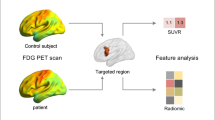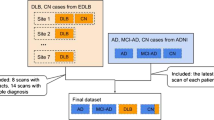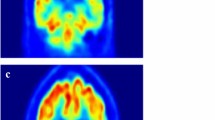Abstract
Purpose
Post-stroke cognitive impairment can affect up to one third of stroke survivors. Since cognitive function greatly contributes to patients’ quality of life, an objective quantitative biomarker for early prediction of dementia after stroke is required. We developed a deep-learning (DL)-based signature using positron emission tomography (PET) to objectively evaluate cognitive decline in patients with stroke.
Methods
We built a DL model that differentiated Alzheimer’s disease (AD) from normal controls (NC) using brain fluorodeoxyglucose (FDG) PET from the Alzheimer’s Disease Neuroimaging Initiative database. The model was directly transferred to a prospectively enrolled cohort of patients with stroke to differentiate patients with dementia from those without dementia. The accuracy of the model was evaluated by the area under the curve values of receiver operating characteristic curves (AUC-ROC). We visualized the distribution of DL-based features and brain regions that the model weighted for classification. Correlations between cognitive signature from the DL model and clinical variables were evaluated, and survival analysis for post-stroke dementia was performed in patients with stroke.
Results
The classification of AD vs. NC subjects was performed with AUC-ROC of 0.94 (95% confidence interval [CI], 0.89–0.98). The transferred model discriminated stroke patients with dementia (AUC-ROC = 0.75). The score of cognitive decline signature using FDG PET was positively correlated with age, neutrophil–lymphocyte ratio and platelet-lymphocyte ratio and negatively correlated with body mass index in patients with stroke. We found that the cognitive decline score was an independent risk factor for dementia following stroke (hazard ratio, 10.90; 95% CI, 3.59–33.09; P < 0.0001) after adjustment for other key variables.
Conclusion
The DL-based cognitive signature using FDG PET was successfully transferred to an independent stroke cohort. It is suggested that DL-based cognitive evaluation using FDG PET could be utilized as an objective biomarker for cognitive dysfunction in patients with cerebrovascular diseases.






Similar content being viewed by others
Data availability
The datasets from our institution analysed during the current study are available from the corresponding author on reasonable request. The datasets from ADNI are available in the LONI Image and Data Archive (IDA) repository, https://ida.loni.usc.edu.
References
Gorelick PB, Nyenhuis D. Stroke and cognitive Decline. JAMA. 2015;314:29–30. https://doi.org/10.1001/jama.2015.7149.
Levine DA, Galecki AT, Langa KM, Unverzagt FW, Kabeto MU, Giordani B, et al. Trajectory of cognitive decline after incident stroke. JAMA. 2015;314:41–51. https://doi.org/10.1001/jama.2015.6968.
Mosconi L. Brain glucose metabolism in the early and specific diagnosis of Alzheimer’s disease. FDG-PET studies in MCI and AD. Eur J Nucl Med Mol Imaging. 2005;32:486–510. https://doi.org/10.1007/s00259-005-1762-7.
Shivamurthy VK, Tahari AK, Marcus C, Subramaniam RM. Brain FDG PET and the diagnosis of dementia. AJR Am J Roentgenol. 2015;204:W76-85. https://doi.org/10.2214/AJR.13.12363.
Jin YP, Di Legge S, Ostbye T, Feightner JW, Hachinski V. The reciprocal risks of stroke and cognitive impairment in an elderly population. Alzheimers Dement. 2006;2:171–8. https://doi.org/10.1016/j.jalz.2006.03.006.
Vinters HV, Zarow C, Borys E, Whitman JD, Tung S, Ellis WG, et al. Review: Vascular dementia: clinicopathologic and genetic considerations. Neuropathol Appl Neurobiol. 2018;44:247–66. https://doi.org/10.1111/nan.12472.
Ihle-Hansen H, Thommessen B, Wyller TB, Engedal K, Oksengard AR, Stenset V, et al. Incidence and subtypes of MCI and dementia 1 year after first-ever stroke in patients without pre-existing cognitive impairment. Dement Geriatr Cogn Disord. 2011;32:401–7. https://doi.org/10.1159/000335361.
Yosinski J, Clune J, Bengio Y, Lipson H. How transferable are features in deep neural networks? Proceedings of the 27th International Conference on Neural Information Processing Systems - Volume 2. Canada: MIT Press; 2014. p. 3320–8.
Oquab M, Bottou L, Laptev I, Sivic J. Learning and transferring mid-level image representations using convolutional neural networks. 2014 IEEE Conference on Computer Vision and Pattern Recognition; 2014. p. 1717–24.
Choi H, Kim YK, Yoon EJ, Lee JY, Lee DS. Alzheimer’s disease neuroimaging I. Cognitive signature of brain FDG PET based on deep learning: Domain transfer from Alzheimer’s disease to Parkinson’s disease. Eur J Nucl Med Mol Imaging. 2020;47:403–12. https://doi.org/10.1007/s00259-019-04538-7.
Contal C, O’Quigley J. An application of changepoint methods in studying the effect of age on survival in breast cancer. Comput Stat Data Anal. 1999;30:253–70. https://doi.org/10.1016/S0167-9473(98)00096-6.
Choi H, Jin KH. Alzheimer’s Disease Neuroimaging I. Predicting cognitive decline with deep learning of brain metabolism and amyloid imaging. Behav Brain Res. 2018;344:103–9. https://doi.org/10.1016/j.bbr.2018.02.017.
Ding Y, Sohn JH, Kawczynski MG, Trivedi H, Harnish R, Jenkins NW, et al. A deep learning model to predict a diagnosis of Alzheimer disease by using (18)F-FDG PET of the brain. Radiology. 2019;290:456–64. https://doi.org/10.1148/radiol.2018180958.
Huang Y, Xu J, Zhou Y, Tong T, Zhuang X. Alzheimer’s Disease Neuroimaging I. Diagnosis of Alzheimer’s disease via multi-modality 3D convolutional neural network. Front Neurosci. 2019;13:509. https://doi.org/10.3389/fnins.2019.00509.
Kim JY, Suh HY, Ryoo HG, Oh D, Choi H, Paeng JC, et al. Amyloid PET quantification via end-to-end training of a deep learning. Nucl Med Mol Imaging. 2019;53:340–8. https://doi.org/10.1007/s13139-019-00610-0.
Liu H, Nai YH, Saridin F, Tanaka T, O’Doherty J, Hilal S, et al. Improved amyloid burden quantification with nonspecific estimates using deep learning. Eur J Nucl Med Mol Imaging. 2021;48(6):1842–53. https://doi.org/10.1007/s00259-020-05131-z.
Liu M, Cheng D, Wang K, Wang Y. Alzheimer’s disease neuroimaging I. Multi-modality cascaded convolutional neural networks for Alzheimer’s disease diagnosis. Neuroinformatics. 2018;16:295–308. https://doi.org/10.1007/s12021-018-9370-4.
Yee E, Popuri K, Beg MF. Alzheimer’s disease neuroimaging I. Quantifying brain metabolism from FDG-PET images into a probability of Alzheimer’s dementia score. Hum Brain Mapp. 2020;41:5–16. https://doi.org/10.1002/hbm.24783.
Xiuli L, Hao Z, Xiaolu Z, Hao L, Guotong X. Exploring transfer learning for gastrointestinal bleeding detection on small-size imbalanced endoscopy images. Annu Int Conf IEEE Eng Med Biol Soc. 2017;2017:1994–7. https://doi.org/10.1109/EMBC.2017.8037242.
Chen WW, Zhang X, Huang WJ. Role of neuroinflammation in neurodegenerative diseases (Review). Mol Med Rep. 2016;13:3391–6. https://doi.org/10.3892/mmr.2016.4948.
Amor S, Peferoen LA, Vogel DY, Breur M, van der Valk P, Baker D, et al. Inflammation in neurodegenerative diseases–an update. Immunology. 2014;142:151–66. https://doi.org/10.1111/imm.12233.
Amor S, Puentes F, Baker D, van der Valk P. Inflammation in neurodegenerative. Dis Immunol. 2010;129:154–69. https://doi.org/10.1111/j.1365-2567.2009.03225.x.
Glass CK, Saijo K, Winner B, Marchetto MC, Gage FH. Mechanisms underlying inflammation in neurodegeneration. Cell. 2010;140:918–34. https://doi.org/10.1016/j.cell.2010.02.016.
Kinney JW, Bemiller SM, Murtishaw AS, Leisgang AM, Salazar AM, Lamb BT. Inflammation as a central mechanism in Alzheimer’s disease. Alzheimers Dement (N Y). 2018;4:575–90. https://doi.org/10.1016/j.trci.2018.06.014.
Sayed A, Bahbah EI, Kamel S, Barreto GE, Ashraf GM, Elfil M. The neutrophil-to-lymphocyte ratio in Alzheimer’s disease: Current understanding and potential applications. J Neuroimmunol. 2020;349: 577398. https://doi.org/10.1016/j.jneuroim.2020.577398.
Brainin M, Tuomilehto J, Heiss WD, Bornstein NM, Bath PM, Teuschl Y, et al. Post-stroke cognitive decline: an update and perspectives for clinical research. Eur J Neurol. 2015;22(229–38):e13–6. https://doi.org/10.1111/ene.12626.
Kalaria RN. Cerebrovascular disease and mechanisms of cognitive impairment: evidence from clinicopathological studies in humans. Stroke. 2012;43:2526–34. https://doi.org/10.1161/STROKEAHA.112.655803.
Funding
This study was supported by the Basic Science Research Program through the National Research Foundation of Korea funded by the Ministry of Education (NRF-2018K1A3A1A39087727, NRF2019R1F1A1059455). This research was also funded by the National Research Foundation of Korea (NRF-2019K1A3A1A14065446), the Korea Medical Device Development Fund grant funded by the Korean government (Ministry of Science and ICT, Ministry of Trade, Industry and Energy, Ministry of Health & Welfare, Ministry of Food and Drug Safety) (Project Number: 202011A06), and Seoul R&BD Program (BT200151). No other potential conflict of interest relevant to this article was reported.
Author information
Authors and Affiliations
Contributions
Ju Won Seok and Kwang-Yeol Park designed the study. Material preparation and data collection were performed by Reeree Lee and Jeong-Min Kim. Imaging analyses were performed by Reeree Lee and Hongyoon Choi. The first draft of the manuscript was written by Reeree Lee and Hongyoon Choi. Data interpretation and critical revision of the manuscript were performed by Ju Won Seok and Kwang-Yeol Park. All authors contributed to writing manuscript. All authors read and approved the final manuscript.
Corresponding authors
Ethics declarations
Ethics approval
All procedures performed in studies involving human participants were in accordance with the ethical standards of the institutional and/or national research committee and with the 1964 Helsinki declaration and its later amendments or comparable ethical standards. This study was reviewed and approved by the Institutional Review Board of Chung-Ang University Hospital (C2015061) and all subjects signed an informed consent form.
Conflict of interest
The authors have no conflicts of interest to declare that are relevant to the content of this article.
Consent to participate
Informed consent was obtained from all individual participants included in the study.
Consent for publication
Patients signed informed consent regarding publishing their data and photographs.
Clinical trial registration
Registration no.: KCT0002462, date of registration: 09/11/2017, retrospectively registered.
Additional information
Publisher's note
Springer Nature remains neutral with regard to jurisdictional claims in published maps and institutional affiliations.
This article is part of the Topical Collection on Neurology
Rights and permissions
About this article
Cite this article
Lee, R., Choi, H., Park, KY. et al. Prediction of post-stroke cognitive impairment using brain FDG PET: deep learning-based approach. Eur J Nucl Med Mol Imaging 49, 1254–1262 (2022). https://doi.org/10.1007/s00259-021-05556-0
Received:
Accepted:
Published:
Issue Date:
DOI: https://doi.org/10.1007/s00259-021-05556-0




